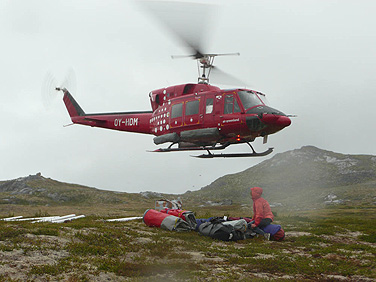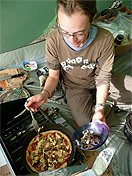This article is from the archives of the UB Reporter.
Greenland provides stark backdrop
for climate change research

The base camp at the lip of the ice sheet is so remote that it takes the team 60 minutes by helicopter to reach it from Ilulissat, a town of 4,000 that is the third-largest settlement on Greenland.
-
-
-
Jason Briner and his students make use of mushrooms that grow on the tundra for their survivalist pizza.
By BERT GAMBINI
- Published: July 5, 2012
At a base camp miles from the western coast of Greenland—north of the Arctic Circle at the margin of an ice sheet that consumes more than 80 percent of the island—UB geologist Jason Briner is conducting climate change research that will help answer pressing questions about rising sea levels.
And he’s making pizza.
“Helicopter charters are a fortune,” he said. “It would cost $5,000 dollars to deliver a pizza this far inland.”
Even if free delivery were an option, it’s unlikely Briner would take anyone up on the offer. His dedication to research and devotion to teaching are not the only reasons he has made an annual summer trip to Greenland since 2008. He’s scheduled to leave for this year’s trip on Aug. 7.
“It’s wonderful bringing students up there,” he said. “I can teach them the etiquette of living outdoors, as well as how to appreciate everything that’s there.”
- ‘Survivor’ 101
Working in such a remote part of the world requires knowledge of survival strategies, but Briner brings verve to his base-camp living approach. His pizza illustrates a demand for creativity. That’s why he’s unwilling to accept prosaic cheese and pepperoni, and chooses to pick mushrooms from the tundra landscape to top what’s being prepared in his tent.
Collecting the meal’s finishing touches, Briner exercises his influence in the kitchen, but does so while walking in one of the few places on the planet that remains uninfluenced by humanity. It is true wilderness.
“One of the reasons I entered this field is because I love the outdoors,” said Briner. “Out here, I can see nature in its prime. It’s peaceful, yet still filled with powerful forces of nature. Greenland is beautiful.”
That beauty is realized within Greenland’s unusual geography. The island, the world’s largest, sits like a massive cap—with only a suggestion of a rising crown and just a sliver of a brim—between the Arctic and North Atlantic oceans. Although Greenland is covered mostly by ice, that coastal brim is ice-free. The majority of the island’s population is settled there, living in brightly colored gable-roofed houses situated on forgiving spots of a gently sloping rocky coastline dissected by narrow bodies of water carved by ancient forces.
Briner’s team flies into a town called Ilulissat. Only 4,000 people live there, yet it’s the third-largest settlement on the island. From Ilulissat, the team takes a 60-minute helicopter flight to a strategic, preselected location at the lip of the ice sheet.
“That’s where we camp out,” Briner said. “We’ll be deeply involved in our research at that location before a helicopter arrives a few weeks later to resupply our food, take the samples we’ve collected and fly us to a different camp.”
Briner’s easy manner makes everything sound simple. But the work is difficult and the task before his team is challenging.
“This is a huge mass of ice, [more than 677,000 square miles]” he said. “There have been no people there to monitor it through time; there has been no instrumentation to monitor what has happened through time. We have data that shows the overall volume of ice is getting smaller, yet we also know that as most parts shrink, some parts might be growing.”
- Collaboration is critical
Briner is one the two people in UB’s geology department who comprise the climate change group. He hopes the group can expand in the future.
His colleague, Beata Csatho, is a glaciologist who studies ice physics and ice flow to determine how the overall health of glaciers and ice sheets changes over time. Castho relies on remote data collection and satellite information.
“That information is current, collected in the last couple decades,” Briner said.
Csatho’s work can be seen as contemporary observation and research, while Briner’s work in paleoclimatology uses various geological techniques, such as studying landforms and applying radio carbon dating, to reconstruct the past changes in the ice sheets to determine when those changes took place.
“We try to put these two traditionally different disciplines of science together to see if we can learn something new. And we’ve done that,” said Briner. “Bea can look at the spatial pattern of how the ice sheet is changing today and I can look at the history of ice sheet to determine if similar pattern occurred in the past. Doing so allows us to bridge the gap between the geologic studies that I do and the contemporary studies that Bea does.”
The two are working on their second National Science Foundation (NSF) grant, titled “The response of the Greenland Ice Sheet to Holocene climate change: Testing ice sheet models and forcing mechanisms of ice change margin.” The grant is awarded through the Geography and Spatial Sciences Program of the NSF, which encourages the integration of geographers and spatial scientists in interdisciplinary research.
This year’s trip is another opportunity to study earth’s history in an attempt to help inform the planet’s future.
“Depending on how things line up, how the answers from looking at the past versus looking at the present come together, we might be able to help in the prediction phase: to see what areas are indeed most susceptible to global warming,” he said.

 Print
Print Comments
Comments


Reader Comments